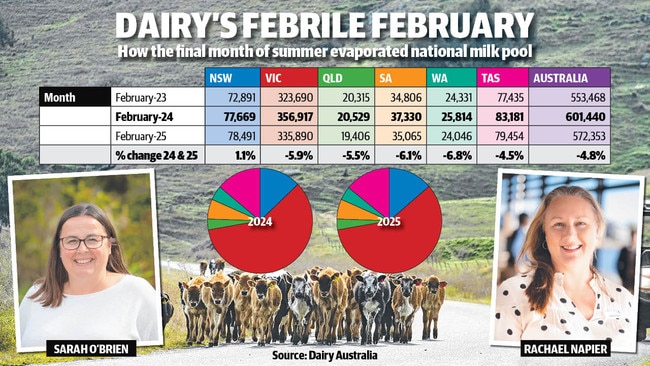Australian milk pool 2024-25: Dairy farmers hopeful for winter
Australia’s milk pool evaporated over summer. But some farmers say it’s not all bad news in some dairy districts. Here’s why.
Australia’s milk pool forecast is holding steady despite bone-dry conditions engulfing much of the southeastern corner of the nation.
The latest production numbers from Dairy Australia show Victoria produced 335,890 litres in February 2025, nearly 6 per cent down on February 2024’s result of 356,917 litres after a dry summer across the state.
However, Victoria wasn’t the worst performer out of the six states with Western Australia’s February 2025 milk output down 6.8 per cent year-on-year, the latest statistics confirm.
GippsDairy chairwoman Sarah O’Brien operates a dairy farm in the Macalister Irrigation District and said it’s very variable depending on where you are in Gippsland.
“Some areas have received below average rainfall for the past 18 months, particularly around Wonthaggi, the Bass Coast and Baw Baw area very much below average.
“East Gippsland had a good start to autumn, which set them up nicely where we are, in the Macalister Irrigation District, we’re in a green bubble where we add water rather than rely on the sky. But rainfall has been average, having rain helps with the dam and the allocation but it’s not the be-all and end-all like some other districts.”
“Gippsland is a more mixed picture — dry in parts, okay in others — than other dairy regions across Australia, where it’s just consistently dry, to the point where it’s been a concern for farmer livelihoods.”

Ms O’Brien said milk production had taken a hit in some parts of Gippsland with autumn key to where the milk pool tally lands by June 30.
“Dairy Australia is forecasting Gippsland to be 2.4 per cent up on last year (for the regional milk pool) but it’s a forecast and if we have a dry autumn, that would obviously cut into production, so we’ve still got three months of the season to play out,” she said.
Murray Dairy chairwoman Rachael Napier operates a dairy farm in the Deniliquin region in NSW and said while water supply was adequate at present, there were concerns about the coming financial year if the dry spell persisted.
“We’ve had a reasonably dry summer. Milk production is fairly consistent though, it hasn’t dropped — if anything it’s risen,” she said.
“Summer rain doesn’t always equal a good milking environment. Irrigation water has been reasonably priced, so that’s allowed for crop investment for this season.
“At the moment, Hume dam is at 25 per cent capacity and this time, last year it was at 64 per cent. So the dry conditions are changing the game already. This time last year we were buying irrigation water at $30 a megalitre to start our own autumn program and this year, we’ve bought water at $100 a megalitre.
“We are irrigating in autumn to get things started because we’re thinking irrigation water is going to be expensive next year and hard to buy, given the contracting dam levels.”
The smallest milk pool in recent seasons was the 2022-23 financial year at 8.125 billion litres, the lowest since the 1994-95 season when it tallied 8.2 billion litres.
Dairy Australia analyst Eliza Redfern said reasonably favourable conditions in both northern Victoria and Gippsland have kept the Garden State’s milk production numbers reasonably strong, despite a drought wilting much of the Western District.
“Victorian milk production this season remains relatively on par with 2023/24 production on a year to date basis, supported by northern Victoria and Gippsland where operating conditions have been comparatively favourable against western Victoria,” she said.
“On the other side of the border, production in southern NSW continues to grow — up 8 per cent on a year-to-date basis — avoiding some of the wet weather that weighs on milk flows in the northern parts of the state.”
Last week, the Bureau of Meteorology released a medium-term forecast which heightened the potential for a drier end to the financial year across much of Victoria.
However, Ms Redfern said NSW and Queensland’s rainfall gains in part off-set Victoria’s dry autumn prognosis.
“Warmer temperatures nationally, dry conditions across southern Australia and wet weather in northern dairying regions weigh on milk flows this season,” she said.
“As such, national milk production remains on track to meet Dairy Australia’s forecast for full season — 2024-25 — volumes to drop slightly by -0.9 per cent to 8.3 billion litres.”





